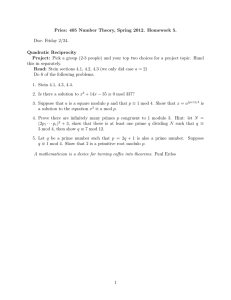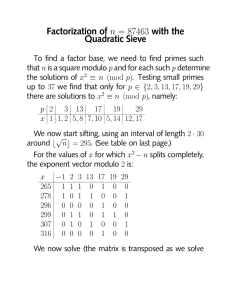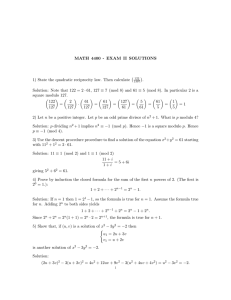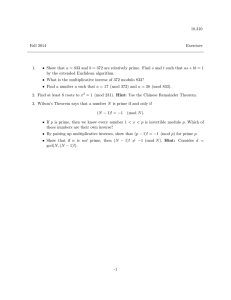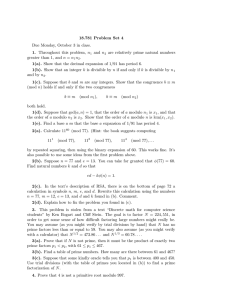Document 13440209
advertisement
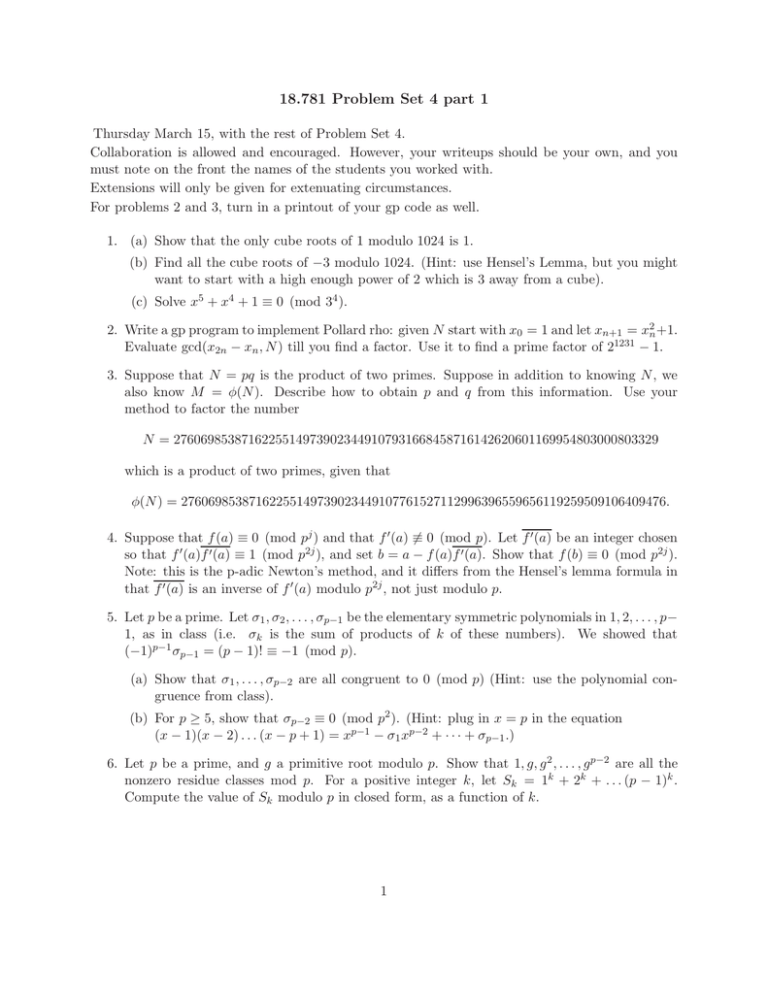
18.781 Problem Set 4 part 1 Thursday March 15, with the rest of Problem Set 4. Collaboration is allowed and encouraged. However, your writeups should be your own, and you must note on the front the names of the students you worked with. Extensions will only be given for extenuating circumstances. For problems 2 and 3, turn in a printout of your gp code as well. 1. (a) Show that the only cube roots of 1 modulo 1024 is 1. (b) Find all the cube roots of −3 modulo 1024. (Hint: use Hensel’s Lemma, but you might want to start with a high enough power of 2 which is 3 away from a cube). (c) Solve x5 + x4 + 1 ≡ 0 (mod 34 ). 2. Write a gp program to implement Pollard rho: given N start with x0 = 1 and let xn+1 = x2n +1. Evaluate gcd(x2n − xn , N ) till you find a factor. Use it to find a prime factor of 21231 − 1. 3. Suppose that N = pq is the product of two primes. Suppose in addition to knowing N , we also know M = φ(N ). Describe how to obtain p and q from this information. Use your method to factor the number N = 27606985387162255149739023449107931668458716142620601169954803000803329 which is a product of two primes, given that φ(N ) = 27606985387162255149739023449107761527112996396559656119259509106409476. 4. Suppose that f (a) ≡ 0 (mod pj ) and that f ' (a) ≡ 0 (mod p). Let f ' (a) be an integer chosen so that f ' (a)f ' (a) ≡ 1 (mod p2j ), and set b = a − f (a)f ' (a). Show that f (b) ≡ 0 (mod p2j ). Note: this is the p-adic Newton’s method, and it differs from the Hensel’s lemma formula in that f ' (a) is an inverse of f ' (a) modulo p2j , not just modulo p. 5. Let p be a prime. Let σ1 , σ2 , . . . , σp−1 be the elementary symmetric polynomials in 1, 2, . . . , p− 1, as in class (i.e. σk is the sum of products of k of these numbers). We showed that (−1)p−1 σp−1 = (p − 1)! ≡ −1 (mod p). (a) Show that σ1 , . . . , σp−2 are all congruent to 0 (mod p) (Hint: use the polynomial con­ gruence from class). (b) For p ≥ 5, show that σp−2 ≡ 0 (mod p2 ). (Hint: plug in x = p in the equation (x − 1)(x − 2) . . . (x − p + 1) = xp−1 − σ1 xp−2 + · · · + σp−1 .) 6. Let p be a prime, and g a primitive root modulo p. Show that 1, g, g2 , . . . , gp−2 are all the nonzero residue classes mod p. For a positive integer k, let Sk = 1k + 2k + . . . (p − 1)k . Compute the value of Sk modulo p in closed form, as a function of k. 1 7. (Bonus) Let p be an odd prime. (a) Let x1 , . . . , xn be variables, and for 1 ≤ k ≤ n, let σk (x1 , . . . , xn ) is the k’th elementary symmetric polynomial in the xi ’s as in class (i.e. the sum of all products of k distinct xi ’s). For instance, σ1 = x1 + · · · + xn σ2 = x1 x2 + x1 x3 + · · · + x1 xn + x2 x3 + . . . xn−1 xn and so on. Note that n � (y − xi ) = y n − σ1 y n−1 + σ2 y n−2 + · · · + (−1)n σn i=1 On the other hand, let Sk be the power sum Sk = xk1 + · · · + xkn Newton’s identities relate the power sums and the elementary symmetric polynomials: kσk = S1 σk−1 − S2 σk−2 + . . . (−1)k−2 Sk−1 σ1 + (−1)k−1 Sk for 1 ≤ k ≤ n. Now let p be a prime and let x1 , . . . xp be 0, 1, . . . , p − 1. Use Newton’s identities (and the result of Problem 5 (a)) to calculate the power sums S1 , . . . , Sp−2 , Sp−1 modulo p. (b) Let f (x) be a polynomial in n variables, of degree d < n. Show that the number of zeros of f modulo p is divisible by p. In particular, if f has no constant term, then show that f (x) ≡ 0 (mod p) has a nonzero solution (a1 , . . . , an ) (i.e. not all the ai are 0 mod p). [Hint: Consider the polynomial g(x) = (1 − f (x))p−1 . What are the possible values of g(a1 , . . . , an ) mod p? Compute the sum � g(a1 , . . . , an ) a1 ,...,an modulo p, where a1 , . . . , an take all pn possible values modulo p.] 2 MIT OpenCourseWare http://ocw.mit.edu 18.781 Theory of Numbers Spring 2012 For information about citing these materials or our Terms of Use, visit: http://ocw.mit.edu/terms.


